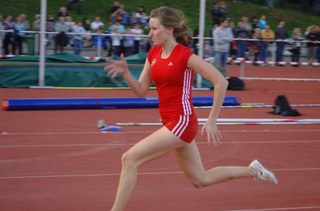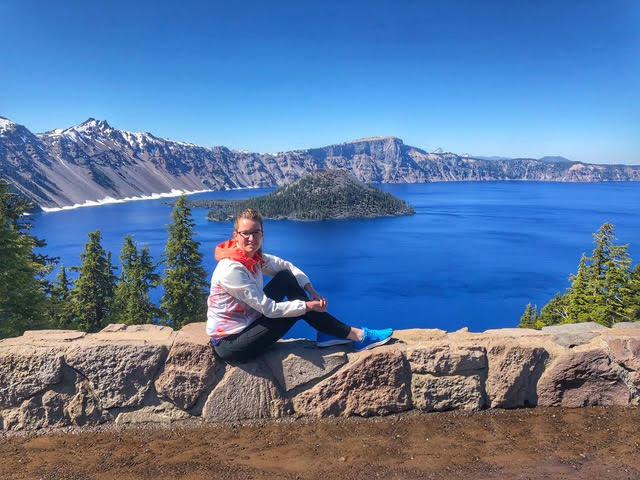
For graduate teaching assistant Alex Szarabajko, being part of the team teaching the 3,000-plus students who take Lifetime Fitness for Health (HHS 231) every term is not just a job. “It’s the last time students are able to learn about physical activity, nutrition and mental health before adulthood, ” says Alex. The course, which tied for first place in a “Best of 2020” vote, lays a foundation for healthy habits by addressing physical activity, nutrition, and mental health. Alex started work on her doctorate in Kinesiology at Oregon State University in 2018 after completing master’s degrees in General Psychology and in Exercise and Sport Science at Eastern Kentucky University. As a researcher in the field of sport psychology, Alex works to understand the reasons that people pursue their fitness goals and engage in healthy behavior.

Alex first came to the United States to work as an au pair in Bethesda, Maryland. Her host family were very enthusiastic about college sports. In particular, Alex wanted to know: “Why are they so popular?” In her native Germany, university sports are not taken seriously. Instead, serious athletes are members of athletic clubs. If athletes are paid at all, it is typically only a small amount. With the exception of footballers, most elite German athletes need supplemental income, often from a career in a more traditional domain. (Link 2) Alex was excited by the idea of college athletes having national attention and earning scholarships through sport. Perhaps this was a way that she, too, could continue to compete, at least for a few more years. After returning to Germany and resuming track and field practice at her local club, Alex began applying for college in the United States. She was recruited by Eastern Kentucky University on a track and field scholarship.
Starting out, Alex thought she had her career path figured out. As a freshman at EKU she was required to go to a majors expo, which she reluctantly attended. At the expo Alex found a booth advertising the field of sport psychology, an experience she describes as an “immediate lightbulb.” She promptly changed her major to psychology to prepare for graduate work in sport psychology.
Following the completion of her bachelor’s degree, Alex stayed at EKU in order to do graduate work under the tutelage of Dr. Jonathan Gore. Psychologists use the term intrinsic motivation to describe actions inspired by internal rewards. For example, a person playing a sport just for fun is intrinsically motivated. Extrinsic motivation describes actions influenced by others. An employee performing a task that they personally don’t care about is extrinsically motivated. Working with Dr. Gore, Alex examined a third type of motivation, relational motivation, among athletes. Relational motivation is defined by the needs of a group. Initially, Alex expected to find that athletes in team sports like football and basketball were more relationally motivated than athletes in individual sports. To their surprise, she found little difference between sports. Instead, she found differences between the levels of relational motivation among female athletes and male athletes. She found that female athletes’ performance was significantly linked to relationships between athletes and coaches.

In 2018, Alex left Kentucky and came to Oregon. She arrived at the start of the academic year, never having been to Oregon before. It didn’t take long for her to feel at home. “I just fell in love with Oregon when I got here,” says Alex. “I was able to go to the coast, go to the waterfalls.” Being near to Eugene (Track Town, USA) is also a bonus: that’s where the 2020 Olympic trials for track and field are being held. Being raised by Polish parents in Germany, Alex speaks both languages fluently and holds citizenship in both countries. She’s volunteered as an official translator for the Polish national team in the past, and hopes to volunteer again for either the German or Polish team.
As a graduate student in Kinesiology with a Psychosocial emphasis, Alex is focusing now on health and fitness in adults, rather than only among adults who consider themselves athletes. About 10 years ago, her advisor, Dr. Bradley Cardinal, carried out a study examining required health classes in colleges and found that since 1930 the number of schools requiring a course in fitness and healthy living has dropped from 80% to 39%. Alex is interested in finding out whether this trend has continued since that study was carried out. Oregon State’s version of the class, Lifetime Fitness for Health, has adapted with time to address student needs. In particular, student responses to end-of-class surveys resulted in the addition of a mental health component the class, which initially only focused on physical activity and nutrition. Alex hopes to uncover more about how required health classes across multiple universities have adapted to changing needs of students, and whether the number of schools requiring such classes has continued to drop.
Tune in Sunday, February 2nd at 7pm on 88.7 FM or online to learn more about Alex’s research and her personal journey!








